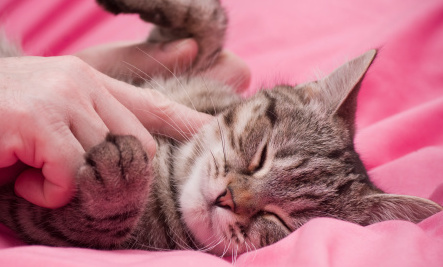A wonderful way to communicate and bond with your cat is through touch. This is really no surprise as domestic cats and humans are naturally drawn to each other physically. Cats love the stroking and petting humans offer, and humans love to feel a feline’s silky soft fur. But did you know that when properly performed, the power of touch, in the form of massage, can be therapeutic for cats? Here is a list of the primary benefits of massaging your feline:
- You can discover previously unbeknownst cuts, wounds, or lumps.
- You can help relieve arthritic pain and joint stiffness.
- You can detect ticks and other parasites.
- Massage helps provide relief for diabetes, kidney disease and inflammatory bowel disease.
- Generally increases circulation of blood and lymph systems and helps eliminate toxins.
- Strengthens bond and trust between cat and owner.
- Gentle massage can reduce aggression and unwanted behaviors.
- Massage can distract your cat while its nails are being trimmed (this will take two people, however).
- Great for calming nervous cats as “feel good” neuro-transmitters dopamine and serotonin are released in the process of being massaged.
- Improves coat quality.
So, how exactly do you massage a cat? Start with a basic massage stroke known as effleurage (French for flow or glide). To maximize the benefits of effleurage, generally work towards the heart. For example start with the toes and work up towards the knee and hips. Use a continuous, straight and slow flowing motion. Other massage movements include:
- Circles: Rotate your fingertips in clockwise or counterclockwise circles about the size of an egg.
- Kneading: Open and shut your palm while pressing lightly with all five fingers along your cat’s spine.
- Petrissage: A deeper massage that involves kneading, loose skin rolling and gently squeezing muscles. My cat, Mittens, loves this on his hamstrings! Combine this stroke with effleurage to encourage toxin release.
- Flexing: After you have warmed-up the muscles with effleurage and petrissage, try gently flexing your cat’s toes, wrists, elbows, ankles and knees, but never with force. You can also try laying your kitty on his/her side and flexing the leg up to the shoulder and back again. Gently shake out the limb with vibrating hands.
- Tapotemont: This technique involves a percussion-like movement of tapping and is good to use after petrissage and flexing.
To get the most out of your kitty massage session, always pay close attention to your cat’s body language. If kitty is relaxed continue with what you are doing, but if your cat nips you, turns away or does any other signaling that it is uncomfortable stop what you are doing and try another location. If kitty repeatedly gives you back-off signals than you should do just that; back off and try again another time. A cat just waking from a nap or in a particularly snuggly mood is the cat most ready for a massage.
A word of precaution: Do not try massaging a cat suffering from a fever, vomiting or one that is in shock. Also, while massage is therapeutic, it should not replace appropriate vet care.
The bonus news about all this feline kneading, flexing and effleurage is that it also relaxes you! Loving contact with animals lowers your blood pressure and calms your nervous system with those same feel good neurotransmitters, dopamine and serotonin, so massage away knowing it is wonderful for both of you.
Check-out the two cat massage videos on the next page. The first is a formal presentation by Animal Friends the other is a funny video of a Thai cat completely blissed-out by a simple shoulder massage. Enjoy.
By: Cherise Udell, Care2.com







